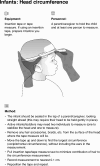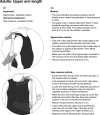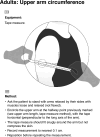Considerations for Anthropometry Specific to People with Disproportionate Short Stature
- PMID: 39907899
- PMCID: PMC11868155
- DOI: 10.1007/s12325-024-03061-y
Considerations for Anthropometry Specific to People with Disproportionate Short Stature
Abstract
In the clinical care of people with disproportionate short stature, healthcare practitioners need to accurately collect anthropometric measurements over time, including height, weight, head circumference, and lengths of affected limb and body segments. Accurate anthropometric measurements are important for diagnostic evaluation, tracking growth, measuring response to pharmacologic therapies or surgeries, and monitoring for potential complications. However, for this clinical population, anthropometric measurements may need to be adjusted or modified to accommodate characteristics such as body disproportions, joint contractures, long bone deformities, spinal deformities, or muscle hypotonia. This article provides guidance for key anthropometric measurements in children and adults with disproportionate short stature, with a focus on people with achondroplasia. The measurements described in this article and illustrated in the infographics can be performed without expensive specialized equipment and are suitable for a variety of clinical settings.
Keywords: Achondroplasia; Anthropometry; Body composition; Disproportionate short stature; Growth; Obesity; Short stature; Skeletal dysplasia.
© 2025. The Author(s).
Conflict of interest statement
Declarations. Conflict of Interest: Julie Hoover-Fong has received honoraria from Ascendis, BioMarin, Innoskel, Medscape, QED Therapeutics, and Tyra for consulting, advisory board, and/or speaking for educational purposes, and participated as an investigator in clinical trials funded by Alexion, BioMarin, QED Therapeutics and Therachon/Pfizer. Oliver Semler has received speaker honoraria and travel support from BioMarin. Bobbie Barron is an employee of and receives funding from the Institute for Clinical and Translational Research, which is funded by the National Center for Advancing Translational Sciences through the Clinical & Translational Science Awards Program, grant number UL1TR003098. Paulo Ferrez Collett-Solberg has received speaker honoraria and travel support from BioMarin and from producers of recombinant human growth hormone. Ellen Fung was previously a consultant to BioMarin, and now receives grant funding from BioMarin for a research study of vosoritide in patients with mucopolysaccaridosis. Melita Irving has received honoraria from BioMarin for speaking, for participating in advisory board meetings, and as a member of the vosoritide experts steering committee. Taichi Kitaoka has received honoraria for lectures from BioMarin. Celide Koerner has no conflicts of interest to report. Keita Okada has received honoraria for lectures and travel support from BioMarin. Katja Palm has received speaker honoraria and travel support from BioMarin, and travel support from producers of growth hormone. Sérgio B. Sousa has received honoraria from BioMarin, Kyowa Kirin, and Ascendis for speaking, for participating in advisory board meetings, and for travel support; and participated as an investigator in achondroplasia clinical trials funded by Ascendis and Therachon/Pfizer. Klaus Mohnike has received honoraria from BioMarin, Novo-Nordisk and QED/Biogridge for speaking, for participating in advisory board meetings, and as a member of steering committees. Ethical Approval: The pilot study briefly described in this commentary was conducted in accordance with ethical principles that have their origin in the Declaration of Helsinki and was approved by the JHMI Institutional Review Board.
Figures









References
-
- Binder G, Ranke MB, Martin DD. Auxology is a valuable instrument for the clinical diagnosis of SHOX haploinsufficiency in school-age children with unexplained short stature. J Clin Endocrinol Metab. 2003;88:4891–6. - PubMed
-
- Savarirayan R, Irving M, Harmatz P, et al. Growth parameters in children with achondroplasia: a 7-year, prospective, multinational, observational study. Genet Med. 2022;24:2444–52. - PubMed
Publication types
MeSH terms
LinkOut - more resources
Full Text Sources

